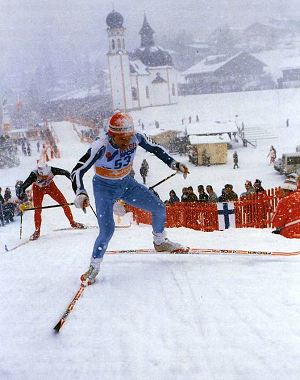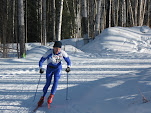Memoirs of a Nordic Berserker I
After a year of trapping and tracking wolves for research in Minnesota, I moved back to Colorado in spring of 1982 and soon declared that I intended to master backcountry telemark turns in the deep powder and to learn country swing. Neither happened. Rather, my life would become about Nordic skating and slam dancing.
I had been an enthusiastic alpine skier since the age of 5, growing up on Colorado’s quiet northern Front Range. I had done some recreational cross country skiing in high school, in Iowa, and after my undergraduate I had even entered a few cross country ski races to supplement my running habit. Those races were fun, but my equipment was shoddy and technique worse, and at times the performance and results outright comical—that is if you think that having your ski fall off a couple times in a race and getting passed by 50-year old grandmas wearing wool knickers and a Dorothy Hamill bob is funny.
Although I was in the best shape of my life in 1983 and posted a sub 33 10k at 6,000 feet altitude and a 2:34 marathon at 5,000 feet, I finished far behind the leaders in the occasional citizens ski race that I’d enter. Broken down from 3,000 miles of running and two marathons by the end of the year, I decided to finally get some decent equipment and join the Colorado State University Nordic ski team, for grins if nothing else.
By the end of 1983, the marathon skate was a commonly used technique among elite Nordic skiers, and even some general sports enthusiasts had heard of Bill Koch and his exploits on the international circuit. Nevertheless, our early on-snow training emphasized lots of over-distance using the traditional (or classic) kick and glide technique. One team advisor even suggested that the marathon skate was over-rated.
What’s This About Slam Dancing?
I had spent the summer of 1982 taking an intensive field course at the Colorado University Mountain Research Station, located at 9,200 feet elevation on Niwot Ridge near Nederland. The Director and many of the staff and students enjoyed going out on weekends for swing dancing. I had no clue as to the steps or how to lead, but joined them once or twice and actually had a good time. So I promised a couple of patient partners that I’d learn some steps.
Meanwhile, I had always wanted to telemark and figuring that at 24 I’d taken the alpine skiing about as far as feasible. Extreme skiing, alpine racing, or freestyle competition didn’t seem as fun as the free-wheeling recreational mogul bashing and tree skiing that I had been used to, but the prospect of hitting a tree or busting a knee on a mogul would not make for a healthy and independent lifestyle. And lift tickets? Forget about it, they were approaching $25 a day, $30 at Aspen or Vail! Telemarking and backcountry looked like a good pursuit.
However, something happened between those heady low oxygenated days on Niwot Ridge and the sun baked foothills and prairie of Fort Collins in a very short period of time. Who knows if was just me, or four zany new roommates? But we bonded by going to local night clubs every weekend, usually more often, where the musical fare was anything but country (with the exception of Neil Young or Commander Cody and His Lost Planet Airmen). We listened to The Clash, The Blasters, Squeeze, The Ramones, The Talking Heads. So much for country swing, and pass another beer thank you very much! Likewise, my next door neighbors were the coordinators and top skiers on the CSU Nordic team and I was intrigued by the sport. Although did join friends on several back country outings, I never had the proper equipment and commitment to learn good telemark techniques.
CSUs Team
Our team leader, Franz Froelicher, was guru skier-coach who always had a funny story up his sleeve, was laid back about everything, except skiing where he was an intense competitor. Franz had had near flawless classic technique, save for skiing a little knock-kneed due to a crushed ankle from a rock climbing fall that nearly took his life a few years prior. At 130 pounds he was our slightly built bionic skier.
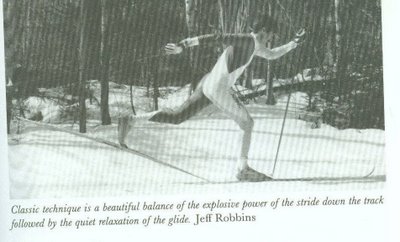
Classic Photo from Morton (1992) Don't Look Back
Also a good skier, Chris Hofer was an easy-going New Jersey native, just my age who had Nordic ski bummed in the Rockies for years and was getting back into school to finish his degree. Going into the season Chris wasn’t in top shape because he’d spent the summer on a fishing boat out in the Gulf of Alaska. He didn’t complain on our 10-12 mile runs, and once on snow he proved to have formidable technique.
John Holcomb (also known as “Ho-hum”) a nickname given by his cyclist friends was so laid back that you’d think he was falling asleep in the middle of a conversation, but watch out when you put him on a bike (he was national class in that sport) or skis, because he was always a scrappy competitor with bottomless lung capacity.
Rounding out our top five for most of the year was Parker, who was insouciant and smart-mouthed. If you looked at him in the right angle, he might even look like Franz’s twin, but Parker had a leg-length discrepancy that made himself three-times more knock-kneed. In a strangely idiosyncratic way, Parker was the spirit of our team of goofy, over-aged (Holcomb was the youngest at 22) college skiers.
Early on we had a true freshman, 18 year old Paul, who was trying to qualify for Junior Olympics. But he moved on after our first race to focus on the JO races and probably to look for more mature company.
Although he wasn’t officially part of the squad, Ray Sharp, a world class and U.S. champion race walker, was with us most of the way through. His girlfriend Wendy was a stellar racer on the women’s team. Ray went along for most races and workouts, if he wasn’t on the U.S. indoor track circuit. Always an intellect, Ray would provide an analytical perspective, like an aerobically gifted Mr. Spock.
The unofficial rite of passage for the team was ski camp in Granby Colorado. We commandeered two mid-sized rooms at the Homestead, and promptly packed in 15 to 18 skiers into a Nordic flophouse. We’d ski two or three hours a day, and devoured stacks of pancakes in the morning and plates of pasta in the evening. Packed like lycra sardines with smelly poly-pro long underwear, we quickly saw who was fit for refugee camp living, and who was not.
Sleep on the first night of camp was near impossible, but we still put in 2.5 hours on the second day. That night I found a little corner space after dinner and slept for 12 hours, with teammates checking in a couple times to see if there was still a pulse. By the third day, Parker and several younger skiers could take no more and they cleared out of that rat's nest. Parker would return for the rest of the season, but a couple of the others never came back.
Through blizzards and sub zero temperatures we traveled in Ray’s 1970s VW bus and trained on the trails at Devil’s Thumb, Snow Mountain Ranch, Silver Creek, and in Grand Lake. Listening to The Dead on the way to yet another long workout, I realized that while not quite counter-culture we were hippies of the 80s. But our LSD to break through to the other side was aerobic development, not psychoactive drugs. By the end of the week, our numbers had dwindled down to just a handful of foolhardy but physically fit souls. We had survived camp and were still speaking with each other. A High Country miracle.
Winter Season 1984
The college season began in January, under record-breaking snow and cold, and even though my technique and placings had improved tremendously from previous years, I finished well back in the early races and did not make the team's top 3 to qualify for the 3 X 5k relay. However, at the end of the month in Park City, Utah we had a brilliant sunny day with temperatures in the 20s and loads of packed snow. I skied unofficially as an extra on the opening leg (not having enough skiers to complete a B team). The course was just an looping circuit through a golf course, with no steep 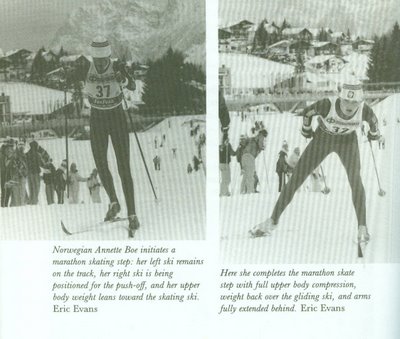 or technical climbs, which made it perfect for the marathon skate.
or technical climbs, which made it perfect for the marathon skate.
Marathon Skate Photo from Morton (1992) Don't Look Back
Like a skateboarder using their rear leg to push themselves down a sidewalk, marathon skate is a pretty simple endeavor. A weight shift is required, but the transfer is not always complete. While my competitors, all good classic skiers, did the diagonal stride most of the way, I instinctively marathon skated as much as I could and finished the 5k with a surprisingly fast split, 2nd fastest on the team, and one of the fastest overall. Seemed like a big breakthrough, but one that didn’t fully arrive for more than a year.
Back on campus and into our classes, we had less time to travel to Nordic centers on the Front Range or Western Slope, but snow cover in town held for weeks. So by skiing we packed down a set of tracks on 1km loop around “Firecracker Hill” (a grassy knoll where the JayCees set off fireworks on the 4th of July), next to the duck pond at City Park. Workouts were usually pretty dull but not to bad if you didn’t mind the footprint pocked tracks and dodging the occasional dog or goose poop. We’d use the diagonal stride and kick double pole techniques through most of the loop, but would marathon skate the four corners. Due to the cold weather in January, the tracks lasted for several weeks.
Most memorable about those sessions, was Pekka, a middle-aged Finlander (Finnish-American from the upper Midwest) and former U.S. Olympic biathlete and Nordic skier. We’d be into 15 or 20 lap workout, and Pekka would appear. We never knew if he lived across the street and waited for us or if he just had special radar for the advent of CSU hack skiers at City Park. However, the ensuing events were predictable. Pekka, was an excellent skier with a fluid and seamless diagonal stride. Our tracks were always a little washed out and squirrelly, but Pekka just floated around the loop like, well, an Olympian. Pekka was also quite out of shape. He’d show up and watch us ski by a couple of times, sizing us up. Then, like a prowling wolf, he’d select one or a few of us as quarry.
As a decent, but not top skier on the team, I was frequent prey. I’d be striding around the track using my still developing but still somewhat stunted stride—not quite shifting my weight with each step, bent forward at the waste a little too much, and not getting all of my weight under the ball of my foot as I tried to set the kick wax onto the snow to gain a not yet powerful push-off. At 25 loaded with endurance, but with a stride best described as work in progress. I’d ski by, minding these shortcomings, when Pekka would suddenly be on my tail, sometimes clicking my skis. He’d never say anything, but standard skier etiquette is to let the faster skier by. So I’d step off and Pekka would stride past, with his swish, swish, swish of each stride drowning out the sound of passing cars. He’d hammer the remainder of the lap, sometimes do another, before stopping to rest for five or ten minutes, and to wait for his next victim.
This was not Finnish-American interval training. It was humiliation by diagonal stride, and like the drip drip of water torture, it would happen over and over within a workout, sometimes several days of the week.
The remaining races in February were under powdery conditions and on narrow trails. We could marathon skate some, but mostly around the turns and on some flats. The good classic skiers ruled these races. Although I was pushing the Chris and John in most races, I slipped back to 4th or 5th on the team.
Our primary National Collegiate Ski Association (NCSA) regional rivals were BYU and the College of Idaho. Schools like CU Boulder, Wyoming, New Mexico, and Utah were literally in a different league, NCAA Division I, where the best Americans and elite Europeans were provided full ride scholarships to ski. Occasionally we would have races with NCAA schools and our division, the non-scholarship NCSA. Racing against the NCAA schools was always a lesson in humility, because we would be so far behind them in the standings.
While prepping our skis for one race, we overheard the Norwegians women from the University of Wyoming, talking in their native tongue, “Bljonie skoolrni, husker du, yadda yadda” in the sing song Scandinavian inflection. “CSU!…..a little silence and many giggles.” Somehow I don’t think that they were admiring our lycra suits!
Even though the NCAA skiers, the Norwegians in particular, just rocketed by, it was always a good learning experience just to watch them glide over the snow at three minutes per kilometer while making it look effortless. They were excellent athletes and in top shape, but what was striking was how they flowed and stayed on top of their skis so well.
As was typical in Colorado, March slipped quietly with mild temperatures and sunny skies, and even the winds were calm. The NCSA championships were just over the Rawahs and Zirkel Wilderness Area that year, in Steamboat Springs. Rather than freeze in an unheated cabin as we did in January, the team rented a spacious house for the four day weekend. So we had an early spring break, with a couple of races to add some excitement.
First up was the 15k, on a challenging trail system at the Steamboat Nordic Center. On the Saturday and Sunday training days we enjoyed sunshine and 30s, with fast snow that ranged from icy powder to granular. Waxing wasn’t too hard, just slap on a binder and some Swix Special Red, and you were ready. However, race day dawned cloudy, warm, and somewhat windy. The tracks were a little icy and more granular, so we added a layer of stickier wax beneath the Special Red.
Soon after the first racers headed out, wet dime-sized snow flakes plummeted from the sky in an angry squall. The flakes built up quickly with two inches with in 30 minutes and the temperature dropped below freezing. John, an early starter, came through his first 3 km with two inches of fresh snow caked onto his kick zone. He had to sit down while we scraped off as much as we could. I had the same wax and only a minute before my own start. No time for panic wax, barely enough for a strip and go. We scraped off the yellow goo, down to the binder, with scarce moments to throw on a thin layer of Extra Blue, with the hope that I’d have at least some kick.
5,4,3,2,1....at the start of NCSA Championships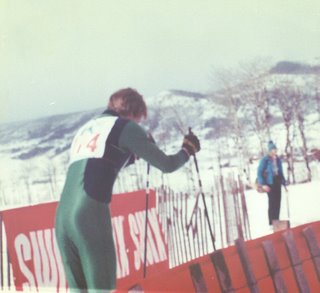
I lined up in the start area and waited my turn for a long 30 seconds. The first downhill was swift on the soft snow that was about the consistency of mashed potatoes left overnight during ski camp at the Homestead. I double poled and glided through the twisting S turns, and even passed a couple of skiers. Then we had to climb back out for a kilometer, and I found that there was no grip. I feared that this would be my worst race of what had only been a decent debut season as a ski racer. There was nothing to do, but jump out of the track and to skate.
I used a mad-frantic diagonal V on the steeper climbs combined with a double pole, or marathon skate on the gradual ups, and double poling on the flats. A few very fast skiers flew by over the challenging course, but I was actually passing more than my share. Several good skiers dropped out or fell back. Other than a very bad fall at the bottom of a steep descent at about 12k, I felt strong throughout and surprised myself as much as anyone. The result was a respectable 27th place, only 9 seconds behind Chris, and about 2 minutes back of Franz, who was 17th. Over the next year I often wondered, if I'd hit the wax right would I have placed higher?
Although there was some controversy within the ranks, I had slam danced into the third
spot for the 3 X 5k relay! I didn’t have the greatest day on the relay, and was outkicked by a BYU skier who I’d beaten most of the year. However, we still finished a respectable 6th overall against a field that included several schools, like Northern Michigan and Minnesota, who had just dropped down from Division I due to budget cuts.
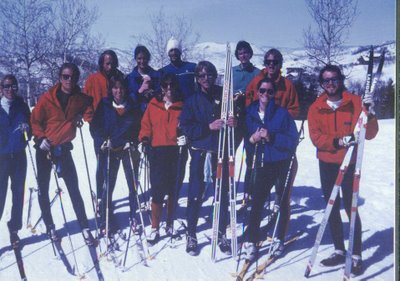
CSU Nordic ski team at NCSA Nationals, March 1984
I went back to Fort Collins, swore off drinking, debauchery, slam dancing, women too, and locked myself into my room for spring break and the rest of the semester. I need time to catch up on all the course work I had missed. It was also time to heal the hip bursitis from the 1983 running year. Other than Parker I didn’t see much of my teammates for the rest of the year, and was oblivious to the inroads in the skating revolution at the Polar Cup in Scandinavia. By then telemark skiing and country swing were all but forgotten.
To be continued...
